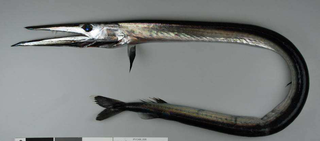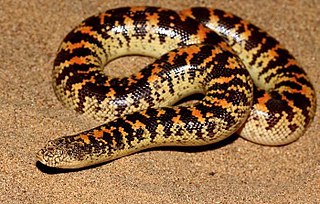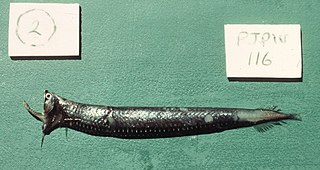| Lestidiops | |
|---|---|
| Scientific classification | |
| Domain: | Eukaryota |
| Kingdom: | Animalia |
| Phylum: | Chordata |
| Class: | Actinopterygii |
| Order: | Aulopiformes |
| Family: | Paralepididae |
| Genus: | Lestidiops C. L. Hubbs, 1916 |
Lestidiops is a genus of barracudinas.
| Lestidiops | |
|---|---|
| Scientific classification | |
| Domain: | Eukaryota |
| Kingdom: | Animalia |
| Phylum: | Chordata |
| Class: | Actinopterygii |
| Order: | Aulopiformes |
| Family: | Paralepididae |
| Genus: | Lestidiops C. L. Hubbs, 1916 |
Lestidiops is a genus of barracudinas.
There are currently 15 recognized species in this genus: [1]

Hemidactylus is a genus of the common gecko family, Gekkonidae. It has 195 described species, newfound ones being described every few years. These geckos are found in all the tropical regions of the world, extending into the subtropical parts of Africa and Europe. They excel in colonizing oceanic islands by rafting on flotsam, and are for example found across most of Polynesia. In some archipelagoes, cryptic species complexes are found. Geckos like to live in and out of houses. They have been introduced to Australia.

Barracudinas are any member of the marine mesopelagic fish family Paralepididae: 50 or so extant species are found almost worldwide in deep waters. Several genera are known only from fossils dating back to the Ypresian epoch.

Oreochromis is a large genus of oreochromine cichlids, fishes endemic to Africa and the Middle East. A few species from this genus have been introduced far outside their native range and are important in aquaculture. Many others have very small ranges; some are seriously threatened, and O. ismailiaensis and O. lidole possibly are extinct. Although Oreochromis primarily are freshwater fish of rivers, lakes and similar habitats, several species can also thrive in brackish waters and some even survive in hypersaline conditions with a salinity that far surpasses that of seawater. In addition to overfishing and habitat loss, some of the more localized species are threatened by the introduction of other, more widespread Oreochromis species into their ranges. This is because they—in addition to competing for the local resources—often are able to hybridize.

Rhinoptera is a genus of ray commonly known as the cownose rays. This genus is the only member of the family Rhinopteridae.

The daggertooths are a genus of marine mesopelagic fish in the order Aulopiformes, the sole genus of the family Anotopteridae. They are found in oceans worldwide, but prefer cooler waters.

Labeobarbus is a mid-sized ray-finned fish genus in the family Cyprinidae. Its species are widely distributed throughout eastern Africa and especially southern Africa, but also in Lake Tana in Ethiopia. A common name, in particular for the southern species, is yellowfish. The scientific name refers to the fact that these large barbs recall the fairly closely related "carps" in the genus Labeo in size and shape. As far as can be told, all Labeobarbus species are hexaploid. One species, L. microbarbis from Rwanda, is known to have gone extinct in recent times.

Eryx jayakari, known commonly as the Arabian sand boa or Jayakar's sand boa, is a species of snake in the family Boidae. The species is endemic to the Arabian Peninsula and Iran where it spends the day buried in the sand.

Stomias is a genus of barbeled dragonfishes. They live in the mesopelagic zone of all oceans and show diel vertical migration and sexual dimorphism (males are smaller, have larger eyes and larger postorbital photophores than females.

Lestidium is a genus of barracudina. They are sometimes referred to as pike smelt.

Lestrolepis is a genus of barracudina.
Macroparalepis is a genus of barracudinas.
Magnisudis is a genus of barracudinas.

Stemonosudis is a genus of barracudinas. These are deep water fish that resemble but are not related to barracuda. They are long and slender with pointed snouts. They are hunters with large eyes and sharp teeth. Unlike barracuda, these fish have no swim bladder.
Macroparalepis affinis is a species of fish which belongs to the Paralepididae (barracudinas) family. The scientific name of this species was first published in 1933 by Ege

Enteromius is a genus of small to medium-sized cyprinid fish native to tropical Africa. Most species were placed in the genus Barbus.

Omanosaura is a genus of lizards in the family Lacertidae. The genus is native to the eastern end of the Arabian Peninsula. There are two recognized species.

Omanosaura jayakari, also known commonly as the Jayakar lizard, Jayakar's lizard, and Jayakar's Oman lizard, is a species of lizard in the family Lacertidae. The species is native to Oman and the United Arab Emirates.

Stemonosudis macrura is a species of deep-water marine, bathypelagic fish living at the depth range 18 to 330 m, member of the barracudina family Paralepididae. The fish is known to distributed in Indo-Pacific and eastern Pacific Ocean from around Point Conception State Marine Reserve in California in the north to Chile in the south.
Lestrolepis luetkeni is a species of fish in the family Paralepididae.
The sharpchin barracudina is a species of fish in the family Paralepididae (barracudinas).